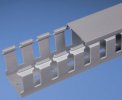britechguy
Well-Known Member
- Reaction score
- 4,770
- Location
- Staunton, VA
A local assisted living facility has asked me to come in and clean up what I'll call "the rats nest" of ethernet cables and power strips with surge suppression that have built up under the two main concierge desks. After looking today, this is going to be more complicated than I had anticipated since I do not and will not even attempt to pull any new cable.
The power strips are an easy wall mount with a couple of screws. There's a UPS that I don't think I'll try to wall mount.
My main idea is to get everything up and hanging either from the underside of the wall mounted desk surface or on the wall itself right under the desk surface and out of sight that I can. What I'm trying to decide on is what is the best system for doing this that would allow for easy additions to, or removal from, the collection of cables as time goes by.
Do folks here have favorite "cable sling" systems or methods that don't involve having to do something like cutting cable ties to remove a cable or replacing them all to re-bundle and re-suspend the existing collection when a new cable might enter the picture? This has got to exist, but I have no idea what it would be called (or who makes it) and would like to have a look at what's out there before submitting a final estimate.
Any ideas?
The power strips are an easy wall mount with a couple of screws. There's a UPS that I don't think I'll try to wall mount.
My main idea is to get everything up and hanging either from the underside of the wall mounted desk surface or on the wall itself right under the desk surface and out of sight that I can. What I'm trying to decide on is what is the best system for doing this that would allow for easy additions to, or removal from, the collection of cables as time goes by.
Do folks here have favorite "cable sling" systems or methods that don't involve having to do something like cutting cable ties to remove a cable or replacing them all to re-bundle and re-suspend the existing collection when a new cable might enter the picture? This has got to exist, but I have no idea what it would be called (or who makes it) and would like to have a look at what's out there before submitting a final estimate.
Any ideas?




